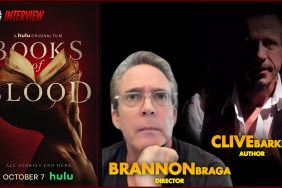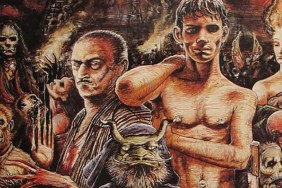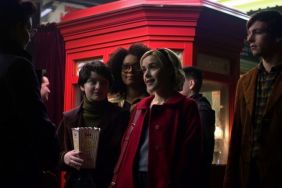Full report, interviews with cast & crew

October, 2008
Anthony DiBlasi might be out of his mind. Or, he might just be the best thing to happen as far as screen adaptations of Clive Barker’s oeuvre are concerned. He commands a set like this writer has never seen before. It contradicts the gravity of the material that creeps along the pages of his script, that permeates the drama and violence he’s putting on film, furthermore, it offsets his quiet English crew who can’t help but have a laugh at his comedic outbursts and spontaneous decisions to, for instance, gnaw on a hunk of fake, disgusting rotted meat for the good of his film (more on that later). To put it bluntly, he makes the set a comfortable home. Albeit, a home that, today, is hosting a bit of axe murder
Here in Egham, England, on the sprawling verdant campus of Brunnel University, shooting is underway on Dread, culled from the pages of Barker’s “Books of Blood.” Inside one of the many frigid buildings fashioned into a soundstage on these rabbit-infested grounds (they’re everywhere), DiBlasi is taking a few axe swings at a mannequin. For the purposes of today’s scene, the usually sharp, curved end of the axe has been cut off and replaced with a magnet which will connect to a piece of metal harnessed to the actor on the receiving end of this killing tool.
“Have a try,” he says, handing me the axe. I give it a swing and the magnet takes purchase on the harness-wearing mannequin. The hold it has is incredibly strong and I feel a bit of sympathy for the actor who’s going to wear it. But only a bit.
Axe murder is just a tip of the iceberg in Dread. A catalyst, in fact, in the warped world of the charming, enigmatic character known as Quaid (Cashback‘s Shaun Evans). He draws film student Stephen Grace (Twilight‘s Jackson Rathbone) into his unfathomable exploration into the nature of fear. Together, they organize a series of interviews, with colleague Cheryl (Hanne Steene), for a documentary on the subject; however, Quaid’s passion for the project becomes increasingly deranged.
Barker’s tale was once housed at 20th Century Fox where writers Drew McWeeny and Scott Swan (Masters of Horror) took a crack at the material. They were followed by Adam Gierasch and Jace Anderson (Night of the Demons remake). Ultimately, Seraphim Films, Barker’s production outfit, rescued the project from a fate worse than anything those suffer in the story. The studio wanted to distill the theme of “Dread” and infuse it with elements of the supernatural. Instead, Seraphim – and its producers Barker, Joe Daley and Jorge Saralegui – partnered with Matador Pictures to make the film. And to do so, they looked to DiBlasi, a Seraphim family member who moved up the ranks from his position as a company intern. DiBlasi rapidly proved himself as a fan of Barker’s work, as a screenwriter and as a producer (Midnight Meat Train, Book of Blood).
Dread marks his feature debut.
Originally, DiBlasi was in line to direct an adaptation of Barker’s “Pig Blood Blues,” but under Seraphim’s deal with Matador (who also produced the John Harrison-directed Book of Blood, a second picture needed to roll and Dread was farther along in development thanks to DiBlasi’s script.
“I always knew what kind of movie I thought Dread should be,” he explains, while his crew prepares for a scene with Rathbone and Evans. Both, I’m told, are en route to the set. “I always wanted it to be more of this coming-of-age, psychological thriller with graphic bits of horror and sex throughout it. I always just felt like it was a story where you really got to know the characters. You dealt with serious issues and you needed really good actors to do it. It was more of a character piece than anything else.”

“This is probably the third or fourth thing I’ve adapted, and even with ‘Pig Blood Blues,’ I tend to just write and then give it to him,” DiBlasi continues, commenting on his collaboration with Barker. “Dread, he was pretty hands-off. What I try to do whenever I adapt Clive’s work is no matter what I change, I always try to stay true to his themes and his characters, especially in the short stories.”
Expansion has been an unenviable task for past filmmakers who have taken on Barker’s stories such as Candyman (“The Forbidden”), Rawhead Rex and the aforementioned Book of Blood. This adaptation in particular has been a formidable challenge for DiBlasi in that “all the lead characters have unique traumas, but in the sense that it needed to feel completely real,” he elaborates. “It wasn’t like all these people came together and were all crazy or had crazy shit happen to them in their childhood. I think we made it organic here. We have a girl who gets abused at a young age by her father. Three out of five girls have that happen to them in some way. We have [Abby, actress Laura Donnelly] who has her own insecurities. I’d say the only one that’s really unique is Quaid whose parents were killed. The biggest challenge was bringing all of these people together and not having it seem like a f**king three-ring circus.”
A trick DiBlasi admits to using when adapting Barker’s story was adjusting the prose, the internal monologue, and turning it into dialogue. As Zack Snyder or Robert Rodriguez would use the comic book pages of Watchmen or Sin City to inform their creative approach, DiBlasi believes in using Barker’s words as a blueprint. “That whole sequence we shot the other day, Quaid’s interview, when he’s talking, I took all that stuff. The line in the story âMy life is a labyrinth,’ okay, let’s just f**king say it.”
Yet, having read the script on the long flight out from Los Angeles to England, this writer can attest that DiBlasi has not just stayed faithful to the story but expanded it organically to the point where one questions the fine differences between Barker’s work and the director’s. The latter, obviously, has no problem pointing them out. The first is the inclusion of Abby, a young woman with a birthmark covering half her body. Also, there are certain character dynamics DiBlasi toyed with.
“When I come to the actors for the first time, I really want them to embrace the characters and change them in whichever way feels natural,” he offers. “I know that Hanne, who plays Cheryl, always related to Quaid in a way. Cheryl and Quaid â in the short story they have a love affair â in the film they don’t. That was all part of Stephen’s journey – winning the girl. But, in the scheme of things, I don’t think he’d ever be the right person for Cheryl. I think Cheryl dominates Stephen. And I think Cheryl has much more of a connection to Quaid because she sees real trauma in him. It’s sort of a love triangle with Stephen in the middle, or essentially, Quaid in the middle. There’s Quaid and Stephen, they grow from each other, learn from each other, and become better people. I always say they both become the men they’re meant to be and Quaid is meant to be what he becomes. Just because it’s dark doesn’t mean it’s not the right path for him. And Jackson, he becomes a much better man, well rounded, but⦔
DiBlasi palpably holds back from saying much more. Just at the right time, too. He’s called away allowing me to wander the set: Quaid’s apartment. Living quarters dominated by earth tones. Sparse. There’s an old furnace in the hallway by the staircase. A vintage toy robot offsets the maturity scattered about the room in the form of vintage books, antlers and bird skeletons – the little corpses found in the chimney of a nearby building by the film’s production designer.
Today’s shoot calls for a lot of blood. Garbage bags serve as raincoats for the crew members who don’t want to get covered in crimson and visible excitement is stretching across DiBlasi’s face as he juggles talking with director of photography Sam McCurdy (The Descent) and approving a prop that will later be strapped around one character’s head to give him the impression that he has gone deaf.

I step outside to breathe some of the crisp air I don’t get in L.A. and meet a member of the security team named Tom, a liver spotted fella with an impressive white mustache. A true vet in the British movie business. He tells me of his time on Richard Donner’s The Omen and when he once served as a driver for Dan Curtis (Dark Shadows). Also, if I looked closely, I’d see him in a crowd shot in one of Hammer’s Dracula films. When Evans and Rathbone arrive on the set, it’s tough to part ways with Tom.
But the two actors reveal they are quite the conversationalists as we began immediately hitting points about Barker’s story that we loved and the facets of Quaid and Stephen that excited them.
“Although the short story definitely gave it a blueprint, I think that the scriptâ¦Quaid’s more of a different character just because of the nature of the two different mediums,” Evans posits. âThe short story, it is what it is, it’s in and itself, whereas for film there’s got to be something slightly more. I’ve found Quaid, in the short story, colder. I felt there’s got to be a thing at the beginning where there has to be a certain charisma to these people where they want to be hanging out together. You’ve got a troubled young man who has some dark things going on. And, he’s fighting himself in many ways, but at the end he’s embraced this darkness, but you have to see that journey and go with it, otherwise what’s the interest in the movie? If he’s the same guy at the beginning, at the end, then there’s no journey.”
Evans says he found the story incredibly sexy, a thought-provoking piece he couldn’t shake. He was eager to explore the skin of Quaid, with DiBlasi’s assistance. “[Quaid] is a guy who’s isolated a lot and yet he’s easy and kind of loose with women, but he doesn’t have any family or real friends around him. Anthony agreed with this, there should be a sense of at the beginning of the film, this guy’s trying in some way perhaps, to make a family. I think that’s what he’s trying to do by painting these strippers. It’s a cathartic thing when you’re an artist of trying to get rid or exorcise demons. But, he’s trying to build relationships with people for the nature of the way his mind works. It can only end in a certain way, but you don’t realize at the time.”
“Stephen pretty much doesn’t have any real friends,” picks up Rathbone. “He’s wrapped up in his brother’s death which happened when he was 15, it’s still one of those things that always eats on him. He’s made a documentary about it and he got past that phase of the dark side of it and tried to look into the light and he’s coasting through. He doesn’t really know what he wants to do. Then comes along Quaid. We go through a lot of these things where Quaid puts Stephen in a situation that has a dark element to it that’s kind of just so enticing and that’s what our film is about in lot of ways, it’s like going to the dark to see the light.”
“Touching the beast,” as Barker puts it in the story, I say.
“Exactly,” Rathbone agrees. “Touching the beast, that’s kind of a shamanistic view. You can go so deep into this world, but you do it for a reason, you want something to come out of it. You want a cathartic feeling and that’s one thing that Stephen’s been searching for in seven years and that’s what he didn’t find with this documentary. He’s starting to get glimpses of that and that’s really what Stephen wants and maybe what he gets too much involved in.”

Rathbone describes Dread as a Kinsey-esque study of fear. “It has those base elements: What are you afraid of? Why are those urban legends urban legends? Why are they told over and over again? Because, those ideas are scary. There have been many documented cases of a complete stranger murdering many people and getting away with it and no one ever knowing why. It’s very rare that you’ll find a film or a piece of literature that delves into the mind of someone that’s been affected by that and what they do to get over it. We all have something in our lives that causes that dread, that inspired it and that’s kind of what we’re trying to get to the root of in this film. Barker’s story did it with such lyrical prose. It’s just beautiful and the imagery is haunting, it really is. We filmed scenes that just made a lot of people sick. Not just because of the gruesome element, but the idea of those situations where youâre like, ‘Yeah, if I was in that situation what would I do?’ And you know what you do a lot of times and you just wouldn’t ever want to think about it.”
That gruesome element he refers to is beginning to come into play when we return to the set. Moments later, blood is spraying, DiBlasi and Jackson are singing “Total Eclipse of the Heart” by Bonnie Tyler and the makeup girl is kind enough to pass out candy, which prompts DiBlasi to joke, “Sweets from the sweet!” Actress Hanna Steen stops by on her day off allowing this writer to get two sides to the much talked about meat sequence, a favorite among those who have read Barker’s story, which took ten hours to shoot.
“The meat scene!” DiBlasi laughs. “When it was at the studio, the first thing everyone wanted to do was cut out the meat scene. They felt like, âWell, it’s unrelatable, she’s a vegetarian, not that many people are vegetarians.â I’m like, âIt has nothing to do with being a vegetarian, it’s the crux of the story and it’s the crux of Dread.’ It’s a genius thing that Clive wrote in such a simple way. I don’t know if he did this subconsciously or really planned it out because it seems like something you’d really plan out, but I bet he really didn’t think about it that much. In the film I gave it more of a personal reason why she has a phobia of meat. But, the meat’s not a big deal. Locking someone in a room with a piece of meat, who the f**k cares, you know what I mean? In the room it’s a battle of will and the battle of will turns into the longer you wait to face your fear, the worse it gets. That is the definition of dread. And, the longer she waits just to f**king pick up that well-cooked piece of meat, it gets rotted and rotted and rotted. By the time she finally breaks and eats it, it’s a degenerated, rotted, maggot-filled piece of meat.”
For Steen, the scene hit closer to home in the sense that she is indeed a vegetarian. However, she pushed herself to the limits in preparation for this pivotal sequence. “I wanted to get a sense of what it feels like to be locked in a room for six days in a room where there’s no natural light,” she explains. “I did a lot of research on solitary confinement and the effects of it. I also asked to be locked in the room where we shot the day before with obviously no phone, no watch, no anything, with just the things that would be there on the day and the meat so I could get a feel for it. It was incredibly helpful. It was really unpleasant, but it really helped me because the first thing that I did was fall asleep and then I woke up and I had no idea how long I’d been there, I had no idea what time it was, I had no idea what was going on and it was scary.”
Cramming what amounts to a six-day imprisonment into a day’s-worth of shooting was strenuous, yet rewarding for the actress who was granted freedom with each take and space to play the scene as long as she needed.
“It was really exciting as an actress, to be able to do that,” Steen says without a hint of sarcasm. “To just be in that room, it was such a great room for it as well because it’s filthy, it smells like shit. There’s the meat there, they have actual meat there. It was gross and I had to pee in the bucket.”
“Because the meat rotted in stages, they had to mold each piece,” DiBlasi adds. “They cast the rotted meat so we could have the silicone meat on the day and then an edible one that she could eat. But, we had the piece of meat in the Tupperware and it had shrunk pretty small. But, there were literally about 500 maggots in it. Those were self-made maggots. All they did was introduce flies and about 500 maggots there and before that shot where she eats the meat for the first time I took it off in that room, everyone behind us is gagging. It had a really good stink and I got it all over my hands when I took off the Tupperware. You can see me in the shot. I slide it into the room and sheâs breathes deeply, she’s leaning into it, smelling it and smelling it and she’s like, âOkay.â And I pulled it away and put the cover back on and then she picks up the meat and starts eating it. Yeah, it was pretty good.”

The scene didn’t end when Steen wrapped for the day. DiBlasi still needed to capture wild sound of meat chewing. “In between takes I brought the bucket and she spit the meat out,” he says with a certain amusement. “But, she’s chewing it and she’s gagging and vomiting. The sound was so great, but I knew that the boom mic wasn’t really close enough to get it. So, for sound I took the meat out of the bucket and was biting into it. It was f**king disgusting. I mean, it tasted like soap in this weird gnarly way. It was very soap-based, it’s like, glycerin-based meat product which tastes like soap. It wasn’t soft. It was like biting into a nasty piece of cartilage, thick. And every time it hit the back of your throat it was like a gag reflex.”
On that note, it’s hard to believe anyone has the stomach for a lunch. Still, following the day’s bit of business involving axes, blood and bodies (of those I cannot identify), the crew breaks for lunch and I’m led by producer Daley to the “meat room” Steen was locked up in.
The windows are partially boarded up and the piss bucket is overturned. In the corner is a sleeping bag torn to shreds. Stains of unknown origin have soaked into the wooden floor. The atmosphere is nauseating. Yet Daley is upbeat in this grim location. Happy because, as he tells me, he thinks Seraphim has a special project on their hands and that DiBlasi has nailed it with this adaptation. “I think it’s extremely faithful to the Barker’s story, even with what was expanded. It has the potential to become a franchisable story.”
Hold on. Sequels?
“If I was to do a sequel to Dread,” DiBlasi elaborates when I return downstairsâ¦to a meal of meat and vegetables, “I don’t know if I would, but I’d turn it on its head again. I wouldn’t want to continue this story about a man exploiting people’s fears. I think the interesting part to tell is to explore his past a bit. But then, put him on the verge of getting married. He’s about to get married, let’s see what happens then!”
Dread has been acquired by After Dark Films and opens in theaters as part of the company’s Horrorfest on January 29, 2010. For a full poster and photo gallery, click here.





Source: Ryan Rotten, Managing Editor









